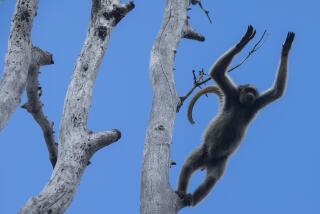Scientist Searches for Man’s Ancestors : Primates: In 30 years, an archeologist has found the remains of 14 or 15 species, the earliest of which is 41 million years old.
- Share via
CAIRO — A scientist scouring a dry, wind-swept Egyptian plain has been unearthing the fossils of primates he believes could be early ancestors of man.
The fossils offer a rough, 30-million-year-old picture of tree-dwelling quadrupeds that probably lived in polygamous groups, according to Elwin Simons of Duke University.
He said the rolling desert north of Egypt’s Faiyoum Oasis was once covered by lush rain forests, and the silt from their rivers left some of the best fossil records on the African continent.
“Everything we know about Old World primates at this age is from Faiyoum,” said Simons. “It is a chapter of history that could show how modern primates developed.”
About 100 rich sites, all inside a tiny egg-shaped area 10 miles long, have yielded turtles, crocodile eggs and elephant-like animals.
In the 30 years he has been working there, Simons has found the remains of 14 or 15 primate species, the oldest from 41 million years ago, and one showing a link to man.
The monkeylike Aegyptopithecus , the size of a small house cat, lived about 32 million years ago. It had the traits of many modern primate species, including a skull with a closed eye socket that is found only in higher monkeys, apes and man.
“Its face is more like that of an ape than a monkey. It could be near the dividing line between Old World monkeys and apes,” Simons said.
Apes, which include gibbons, orangutans, chimpanzees and gorillas, have no tails and resemble humans more closely than monkeys.
Simons believes Aegyptopithecus could be the ancestor of the apelike Proconsul found in Kenya and dating back 18 million to 20 million years. He believes primates most likely originated in Africa.
Proconsul is at the top of a family tree found in Kenya whose possible descendants include Kenyapithecus or Dryopithecus (14 million to 11 million years ago) and Australopithecus (5 to 1 million years ago), which was discovered by Louis Leakey at Oldevai gorge in Kenya.
Paleontologists believe modern man, or Homo sapiens , which first appeared about 1 million years ago, is almost certainly the descendant of Australopithecus.
“If you want to study man’s ancestors, the first chapter is the stages leading up to the appearance of man. You don’t get real humans until about 4 million years ago,” said Simons.
Simons was drawn to Egypt in 1958, when he came across a skull from Faiyoum while working in the American Museum of Natural History in New York.
His 1960 visit to Faiyoum was the first by a scientist since 1911, when the earliest monkey fossils were found.
He quickly found fossils from several primates and has been collecting 20 to 40 specimens every year since.
Simons has found a way to let the wind do his digging for him in the unusual terrain where he works.
He marks off a small piece of land and removes the “desert pavement” of rocks, solidified wood and other hard objects.
“If you remove the rocks, some 4 or 5 inches of sand will be blown away by the next year. Fossils are left in the holes,” he said.
He calls the process “wind harvesting.”
“As far as I know it is the only place in the world where you can work like this,” he said.
More to Read
Sign up for Essential California
The most important California stories and recommendations in your inbox every morning.
You may occasionally receive promotional content from the Los Angeles Times.









